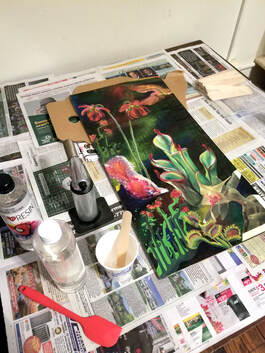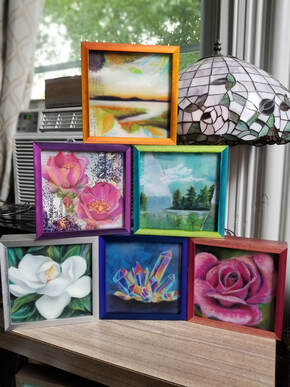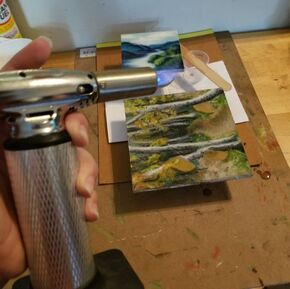 As an artist with a history working for art supply retailers, I have a tendency to look at artwork and try to figure out how it was made. I can’t help but ask: "What did you use? How did you use it? Is it archival? Can I use this technique or material in my own work?" When I saw a small multilayered piece by Lauren Arno- a gorgeous floral watercolor with mixed media inclusions and a thick glossy layer on top- at a local art show I was taking part in, I needed to know what she’d used. I tracked her down at the art opening, and thankfully she was more than willing to talk shop, and introduced me to the absolute fricken wonder that is ArtResin. ArtResin is a two part epoxy clear coat that you can pour over nearly anything. It dries in 24 hours, self levels to give a smooth coat, and is non toxic and produces no VOCs or fumes. It’s UV protective, food safe, and heat resistant up to 120F. It. Is. AMAZING. As an art materials professional, let me just say- a clear coat that is food safe, UV protective, AND non toxic during pouring is SO RARE. To have it also be affordable and durable makes ArtResin a damn unicorn among art supplies. The first time I used it, I literally said “Where have you been all my life?!” I cannot recommend it enough. It’s truly an amazing product to have in my art arsenal. I work with oil pastels, which occupy a weird grey zone of art supplies. They are a lot more stable than soft pastels, which can be obliterated by a stray swipe of the arm or a stiff breeze. Unlike oil paints, however, oil pastels never fully dry. This makes oil pastels difficult to display: if they were truly paintings, they could be hung on the wall as-is, no glass. If you treat them like drawings, you have to frame them properly, which can be prohibitively expensive. Oil pastels make mixed media pieces tricky to do. When you layer art materials, you should generally try to follow “Fat over lean”. This means that it’s hard to layer something “leaner” (i.e. less oily) like acrylics, or watercolor, or even glue or modpodge over oil pastel. Oil repels water, and water-based materials don’t want to stick to oil pastels. I’ve tried a number of different coatings to protect and finish my pastels- varnish, brush on glazes, fixatives, and sprays. ArtResin has worked the best out of anything I’ve used in 25 years of art.  ArtResin allows me to layer things by encapsulating them. I don’t have to worry about something not sticking to oil pastels when I just embed them into a layer of resin. I can incorporate glitter, pigments, textured papers. I don’t have to worry about glass- ArtResin acts as a fantastic shield against scratching and damage, and protects from fading and bleaching too. I personally can’t get enough of the shiny gloss coat, as well- it intensifies my colors and gives everything a fully finished look which I love. I’ve also got to give a shout-out to their website- it includes incredibly in depth FAQs, instructions on the peculiarities of using ArtResin on a wide range of substrates and materials, and even a smartphone level that makes pouring the resin much simpler. The company really has a scientific and inquisitive mindset, and cares about their product and how it works. The Frequently Asked Questions are more like “Questions Asked EVER” in that they cover everything from “What happens if it freezes?” to a slew of “Can I use this on X?” inquiries, plus all the instructional videos you could ever want. Being a huge nerd about art materials, this is the kind of transparency I want from all my art materials manufacturers. Art is about experimentation, and they do a really great job of keeping all that info in an easily accessible place.  There are, of course, things I need to be careful of when using ArtResin. The ArtResin doesn’t stick well to straight oil pastel either, so a layer of some kind of clear coat is essential. As with any resin you have to be mindful of hairs, dust and dirt getting caught in the mix. It’s not toxic but also not great for sensitive skin, so gloves and attention are important while working with the liquids. It has a long “open” time, so you have to protect the resin while it sets (in an apartment with cats, this can be tricky). You also remove little bubbles in the resin by torching it with a creme brulee torch, which can feel a little intense, especially if your studio space is also your living space. Overall though, ArtResin gives me a freedom to do things with my artwork that aren’t feasible any other way. I’ve already used it on my artwork, especially smaller pieces that would be annoying to glaze, on a glittery phone case (no one wants stray glitter around, bonded glitter only!), and am planning on using it on serving trays, coasters, tabletops, cups and more. While selling my work, I have found that people who feel leery about spending a lot of money on a framed traditional artwork are sometimes much more willing to buy something that’s both artistic and functional (like a tray, or furniture, or a jewelry box), so this gives me the freedom to expand what I have for sale. It really opens so many doors and puts so many possibilities within reach. I can't wait to see all the new uses people will find for ArtResin, and how I'll push my art further using it in the future!
2 Comments
11/13/2022 09:57:21 pm
Thank you for pointing out how uncommon it is to find professional art supplies with a transparent finish that is food safe, offers UV protection, and is non-toxic when poured. My daughter wants to take up a brand-new craft. I'll acquire non-toxic and secure resin art supplies.
Reply
Leave a Reply. |
AboutThoughts, feelings, opinions and lessons about oil pastels, art retail, and other artist's concerns. ArchivesCategories
All
|
 RSS Feed
RSS Feed